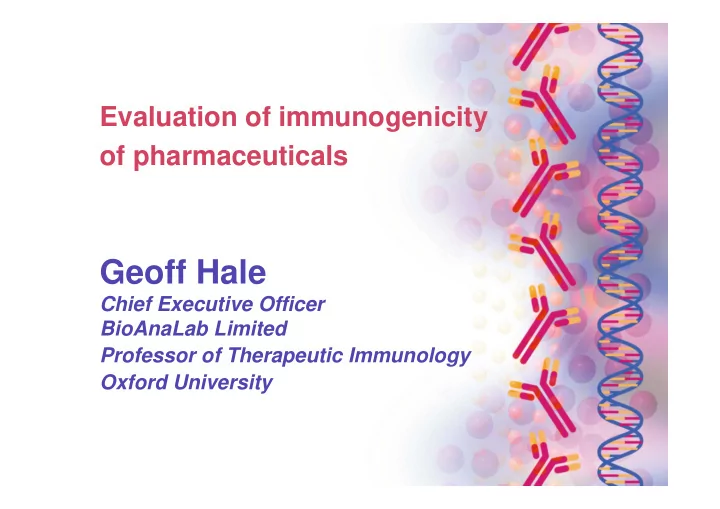

Evaluation of immunogenicity of pharmaceuticals Geoff Hale Chief Executive Officer BioAnaLab Limited Professor of Therapeutic Immunology Oxford University
Guideline on Immunogenicity Assessment of Therapeutic Proteins. EMEA/CHMP/BWMP/14327/2006 Mire-Sluis AR, Barrett YC, Devanarayan V et al. (2003) Recommendations for the design and optimization of immunoassays used in the detection of host antibodies against biotechnology products. J. Immunol. Meth . 2004; 289:1-16.
Principles • Primary concern is clinical sequelae • Assessment requires appropriate assays • Wide range of technical difficulties • Immunogenicity assays are quasi- quantitative due to lack of reference • Titre-based approach is preferred • Recommendations are based on experience and not a substitute for regulatory guidance or intended to stifle innovation.
Topics • Cut point and assay sensitivity • Quantitation • Confirmatory Assays • Validation.
Binding to CD52 antigen (Antagonist effect) 1.6 Glyco1 1.4 Optical Density 1.2 Campath 1.0 0.8 0.6 0.4 0.2 0.0 10 100 1 1000 Concentration (ng/ml)
Cell-Mediated killing (ADCC) (Agonist effect) Glyco1 100 Specific cell killing (%) Campath 80 60 40 20 0 0.01 0.1 1 10 100 1000 Concentration (ng/ml)
Screening Assay – Cut Point and Sensitivity EMEA Mire-Sluis Clients “Detection of some “It is appropriate to The cut point will be false positive results is have 5% false 1.645 SD above the inevitable” positives” mean “eg 3SD above background” “Capable of detecting “Strive for sensitivities Sensitivity must be less antibodies in all near 250 to 500 ng/mL” than 500 ng/ml and the antibody-positive lower the better samples/patients”
The following slides illustrate the effect of different levels of biological variability (Bio SD) and analytical variability (Assay SD) on the determination of “positive” samples, using sets of normally-distributed random data. It is shown that even a small level of assay variability can lead to highly non-reproducible results and when the assay variability is comparable with the biologic variability, the cut-point methodology proposed by Mire-Sluis has no useful value.
Bio SD=0.00 Assay SD=0.02 0.160 0.140 0.120 Response (AU) 0.100 0.080 0.060 0.040 0.020 0.000 0 5 10 15 20 Serum number
Bio SD=0.02 Assay SD=0.01 0.160 0.140 0.120 Response (AU) 0.100 0.080 0.060 0.040 0.020 0.000 0 5 10 15 20 Serum number
Bio SD=0.02 Assay SD=0.005 0.160 0.140 0.120 Response (AU) 0.100 0.080 0.060 0.040 0.020 0.000 0 5 10 15 20 Serum number
Cut Point and Sensitivity - a case for “case by case” Consider: • Clinical consequences of antibodies • Therapeutic concentrations of drug • Likely frequency of antibodies • Biosimilars – similar assay or not?
Quantitation of Response EMEA Mire-Sluis Clients “(Positive) samples “Due to the quasi- Often require need to be quantitative nature of calibration curves and characterised in terms immunogenicity QC samples with same of antibody content assays, we advocate a acceptance criteria as (concentration/titre)” titer-based approach” other ligand-binding assays
Confirmatory Assays EMEA Mire-Sluis Clients “Usually advisable to “Immunodepletion Help!! use a different assay assay: a form of format” confirmatory assay”
Different format? • More sensitive Why not use as screening assay? • May find positives among control • samples which screened negative • Less sensitive Fail to confirm true weak positives •
Same format? • Compare pre and post-treatment Treatment emergent response • • Drug inhibition (immunodepletion) Drug-specific response •
The following slides illustrate the effect of small sample size on the results of a confirmatory assay which is evaluated by a simple t-test. There is little difficulty in confirming a strong positve response which Is fully inhibited by addition of drug. However, weak responses may sometimes be confirmed and sometimes not and the result of a particular assay is unpredictable. Improvements in assay precision can even be counter-productive, allowing small differences to falsely appear statistically significant.
0.300 0.250 0.200 Signal (AU) 0.150 0.100 0.050 0.000 PRE POST SPIKE True positive, confirms treatment-emergent and drug specific
0.300 0.250 0.200 Signal (AU) 0.150 0.100 0.050 0.000 PRE POST SPIKE False positive, confirms negative
0.300 0.250 0.200 Signal (AU) 0.150 0.100 0.050 0.000 PRE POST SPIKE False positive, but confirms treatment-emergent and drug specific
0.300 0.250 0.200 Signal (AU) 0.150 0.100 0.050 0.000 PRE POST SPIKE False positive, but confirms treatment-emergent and drug specific
Validation EMEA Mire-Sluis Clients “… ensure all essential “The validation process Validation to be procedures are in place will be discussed in a completed before before commencement subsequent starting clinical trials, (of the clinical study). manuscript” but guidance needed This includes … on how to do it. validation of all assays”
Problems with pre-study validation • Lack of suitable positive control • Lack of suitable negative controls • Lack of understanding of potential frequency and magnitude of responses
Pre-validation studies and early phase clinical trials • Demonstrate analytical capabilities using surrogate reagents • Determine potential analytical range and acceptance criteria • Carry out in-study validation during Phase I clinical trials, eg local cut-point with local assessment of sensitivity • Collect samples for positive controls
Recommend
More recommend